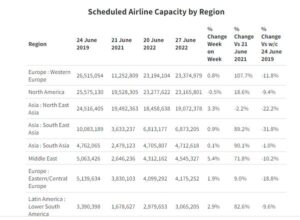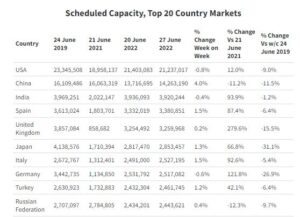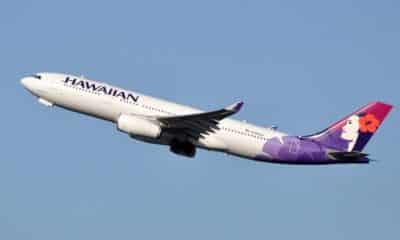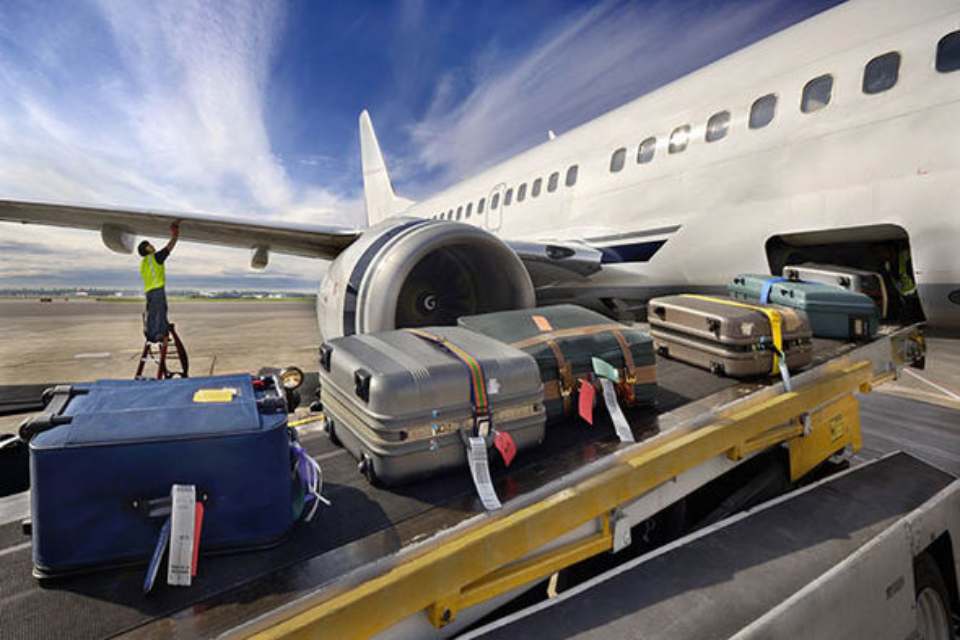Aerospace
The Airbus A380 is getting ready to fly again and Capacity Edges to 100 Million : OAG
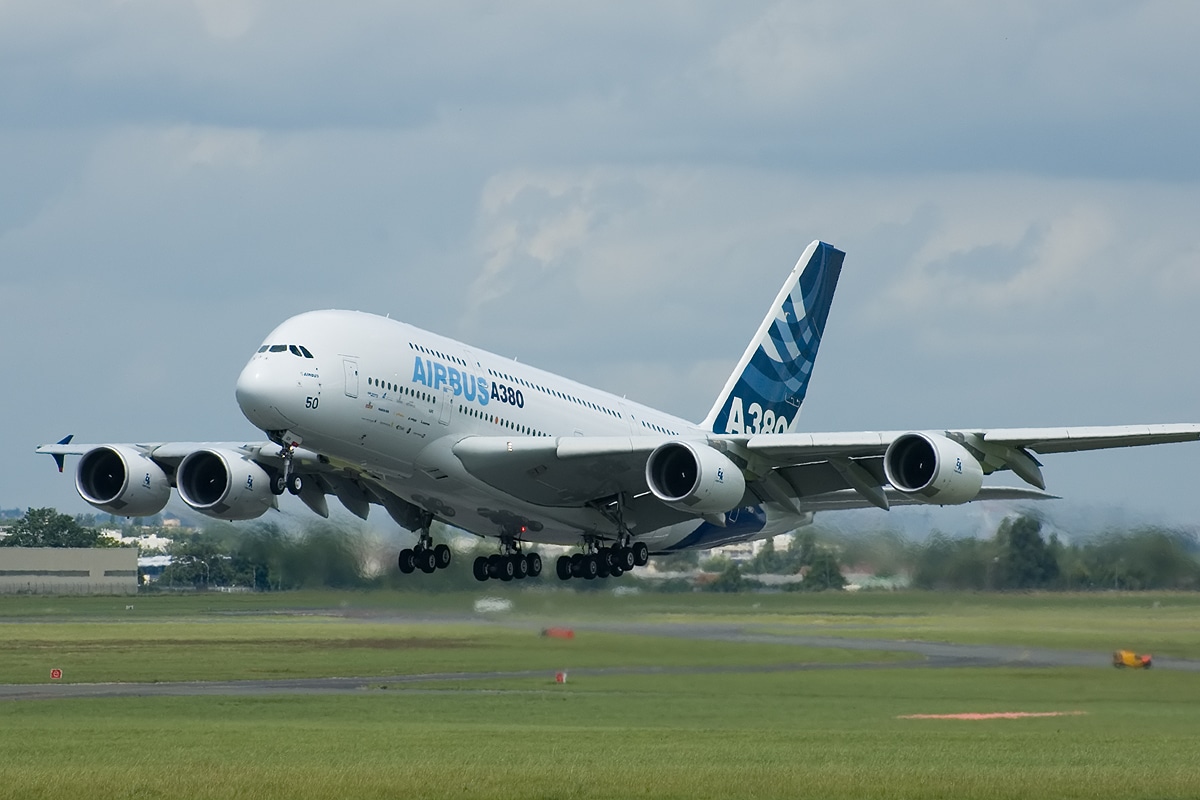
The Airbus A380 is getting ready to launch once more, and capacity is approaching 100 million.
With the forthcoming Fourth of July vacations, will we pass the 100 million seat threshold next week when airline capacity has settled at 99.9 million seats? Possibly or not!
Last week, the IATA AGM came to a successful conclusion. Delegates were entertained by a local folk ensemble and performances by Christina Aguilera and Jennifer Lopez, who both travelled long distances to attend the event.
When the Dutch Government announced a 20 percent cut in movements at Amsterdam Schiphol, the staff members at the IATA Slot Conference in Seattle were busy. How on earth airports and airlines can create long-term plans with such impulsive decisions is beyond me.
Will Lufthansa and Etihad add the Airbus A380 to their fleets again?
According to reports, two airlines—Lufthansa and Etihad—are thinking of reintroducing the Airbus A380 to their fleets to get around upcoming supply issues. How rapidly things improve, and let’s hope that continues to be the case. Nine carriers will run just under 1,000 A380 flights this week, with Emirates accounting for 70% of those, British Airways for 9%, and Qatar Airways for a very hesitant 7%. In 2019, fourteen airlines operated more than 2,300 A380 services.
The recovery is still going strong, according to forward-looking airline capacity through the end of September. Despite a lower starting point, capacity declined by 7% in September 2019 compared to August, and this September is presently 4% below August. This shows ongoing optimism in the recovery. With almost 30% greater capacity and most likely above 85% of the 2019 level, September will be substantially stronger than last year, even after accounting for the probable drift of some capacity in the upcoming months.
Western Europe is once again at the top of the lists this week thanks to a shift of less than 1% in the two biggest markets in the world, at least until easyJet makes their announced capacity adjustments and other airlines modify their schedules. Given that public holidays typically have a minor negative influence on capacity and that the United States will be “celebrating” Independence Day next week, it is likely that the positions will not alter.
The Regional Markets in North Africa and the Middle East are Growing the Fastest
The fastest rising regional markets this week were in North Africa (+7%) and the Middle East (+5%), both of which reported gains of more than 75% over the same week last year. With the exception of North East Asia, every region in the world now has significantly more capacity operating than it did a year ago, and half of those regions report more than 50% growth. This is quite remarkable and explains why airlines are simultaneously running out of resources and frantically seeking out new aircraft.
Read more OAG report.

Aerospace
Which is bigger 777x or 787 aircraft ?

The 777X is a new series of the Boeing 777 family and is designed to be larger and more efficient than its predecessor. It features two variants: the 777-8 and the 777-9, being the larger of the two.
The Boeing 777X emerges as the larger sibling within the Boeing family, representing a significant leap forward in both size and efficiency. Comprising two variants, the 777-8 and the 777-9, the latter takes the crown as the larger of the two. With its expansive fuselage and impressive wingspan, the 777X is tailored for long-range journeys and boasts a substantial passenger capacity.
On the other hand, the Boeing 787, affectionately known as the Dreamliner, occupies a niche in the market as a smaller yet formidable aircraft designed for medium to long-range flights. Its distinguishing feature lies in its composite fuselage, a technological marvel that renders it lighter and more fuel-efficient compared to conventional aluminum counterparts. The Boeing 777X is larger than the Boeing 787 aircraft.
When it comes to passenger capacity, the 777-9 reigns supreme, typically accommodating a sizeable contingent of 400-425 passengers in its standard configuration. In contrast, the 787, with its more modest dimensions, typically carries between 240-290 passengers, depending on the variant and layout.
One of the remarkable innovations introduced with the 777X is its folding wingtips, a feature designed to address the logistical challenges of accommodating such a large aircraft in conventional airport gates. These folding wingtips enable the 777X to retract its wings, allowing it to fit into gates designed for smaller aircraft while still reaping the benefits of an extended wingspan during flight, thereby enhancing fuel efficiency and operational flexibility
Aerospace
China Secures Production Certificate for Mass Production of Pilotless eVTOL Aircraft

The first passenger-carrying pilotless electric vertical takeoff and landing (eVTOL) aircraft in the world, the EH216-S, has received the Production Certificate for its eVTOL aircraft from the Civil Aviation Administration of China (CAAC).
This is a significant milestone for EHang Holdings Limited, the leading UAM technology platform company in the world. This outstanding accomplishment is another big step towards mass manufacturing for the eVTOL aircraft and the ensuing commercial operations, building on the ground-breaking acquisition of the Type Certificate and the Standard Airworthiness Certificate for the EH216-S.
The PC is a crucial certificate that the aircraft maker receives from the CAAC, the country’s aviation authority. By obtaining this certificate, EHang has demonstrated that it has set up a quality management system for mass production that satisfies the airworthiness regulation standards set forth by the CAAC, and the company has been given permission to continue producing mass quantities.
It is also a strong guarantee of the calibre of the goods made by EHang. Raw materials, supplier management, manufacturing organisation, production quality control, aircraft pre-delivery test, after-sales repair and maintenance, etc. are all included in the mass production quality management system for the EH216-S.
To ensure that every aircraft and its components that roll off the production line strictly adhere to the approved type design and safety requirements, the system sets clear guidelines and documentation for every step in the production procedure. This ensures comprehensive traceability and safety control.
Aerospace
Four Airbus A380 Superjumbos lined up to be scrapped

In a strategic move aimed at reclaiming valuable resources from the iconic Airbus A380 aircraft, VAS Aero Services and Dr. Peters Group have announced a significant collaboration.
This partnership marks a milestone in aviation logistics and aftermarket services, with four of these colossal planes slated for teardown and redistribution of used serviceable material (USM).
The venture between VAS Aero Services, renowned for its expertise in aircraft dismantlement, and Dr. Peters Group, a prominent Germany-based investment fund management firm, underscores a commitment to sustainable aviation practices. This isn’t their first foray into scrapping A380s; their successful partnership has already seen the dismantlement of these aircraft, making them pioneers in this niche.
Under the agreement, the latest consignment brings the tally to eight A380s entrusted to VAS by Dr. Peters Group. Managing Director Christian Mailly of Dr. Peters Group emphasized the trust placed in VAS, citing their unparalleled capabilities in dismantlement and aftermarket sales network. It’s a strategic move in response to the growing demand for quality USM parts, particularly with the resurgence in reliance on the A380.
Notably, the teardown process will be carried out at various locations, optimizing the positioning of harvested parts to cater to different markets. While some parts will be positioned in Europe to support operators in the region and the Middle East, others will remain in the Asia-Pacific region. This meticulous strategy ensures efficient access to spare parts, benefiting MROs and airlines across these markets.
The decision to retire these A380s comes at a time when operators are reassessing fleet strategies amidst evolving market dynamics. Despite initial plans for quick retirement due to the emergence of more fuel-efficient alternatives, factors such as a rebound in long-haul demand and delays in new widebody deliveries have prompted operators to reconsider. The A380, with its unique capacity and capabilities, presents a practical solution for short-term capacity management.

